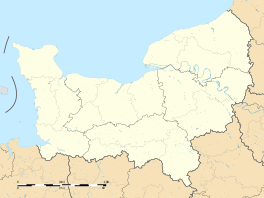Louviers
| Louviers | ||
|---|---|---|
|
||
| Coordinates: 49°13′N 1°10′E / 49.22°N 1.17°ECoordinates: 49°13′N 1°10′E / 49.22°N 1.17°E | ||
| Country | France | |
| Region | Normandy | |
| Department | Eure | |
| Arrondissement | Les Andelys | |
| Canton | Louviers-Nord and Louviers-Sud | |
| Intercommunality | Communauté d'agglomération Seine-Eure | |
| Government | ||
| • Mayor (2014–2020) | François-Xavier Priollaud | |
| Area1 | 27.06 km2 (10.45 sq mi) | |
| Population (2011)2 | 17,697 | |
| • Density | 650/km2 (1,700/sq mi) | |
| Time zone | CET (UTC+1) | |
| • Summer (DST) | CEST (UTC+2) | |
| INSEE/Postal code | 27375 / 27400 | |
| Elevation | 11–149 m (36–489 ft) (avg. 15 m or 49 ft) |
|
|
1 French Land Register data, which excludes lakes, ponds, glaciers > 1 km² (0.386 sq mi or 247 acres) and river estuaries. 2Population without double counting: residents of multiple communes (e.g., students and military personnel) only counted once. |
||
1 French Land Register data, which excludes lakes, ponds, glaciers > 1 km² (0.386 sq mi or 247 acres) and river estuaries.
Louviers is a commune in the Eure department in Normandy in north-western France.
Louviers is 100 km (62 mi) from Paris and 30 km (19 mi) from Rouen.
In the area around Louviers, cut stones from the Paleolithic era have been found. Some of these are in the town's museum, alongside fragments of a mammoth tusk found not far from the cemetery. Other evidence of human presence in the area at different periods of prehistory includes the menhir of Basse-Cremonville and the Neolithic tomb which was close to it. Various objects from these periods - weapons, vases, stone and bronze tools - have also been found in the area.
A few elements dating from the period of Ancient Gaul have been found at Louviers: a Celtic grave found in 1863 against the wall of the Église Notre-Dame, and several Gallic coins. A hypothesis of a fortified Gallic village has been formulated, but not proven. The Louviers of Roman Gaul is, however, better known. It was not, however, unimportant, as judged by the fact that it appeared in neither the Antonine Itinerary nor the Tabula Peutingeriana.
Under the Merovingians, Louviers had at least two cemeteries, but it is only from the 9th Century that certain historical events can be dated.
During the French Revolution, Louviers' citizens were moderate in their cahiers de doléances (grievances presented to the king), and followed the currents of thought and action of the rest of the country. This moderation was shown by constitutional royalists at the time of the first two revolutionary assemblies; by Girondists at the start of the National Convention, and by the Thermidorian Reaction after the execution of Robespierre.
...
Wikipedia



